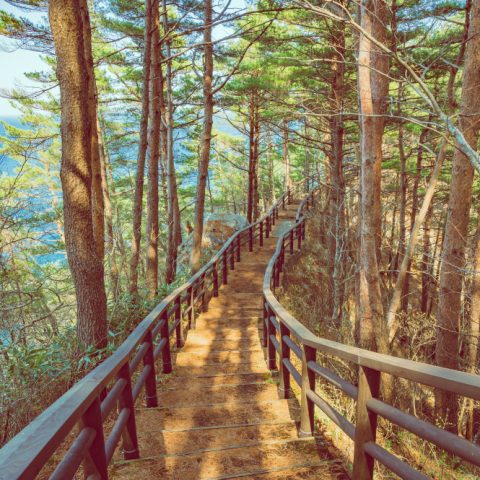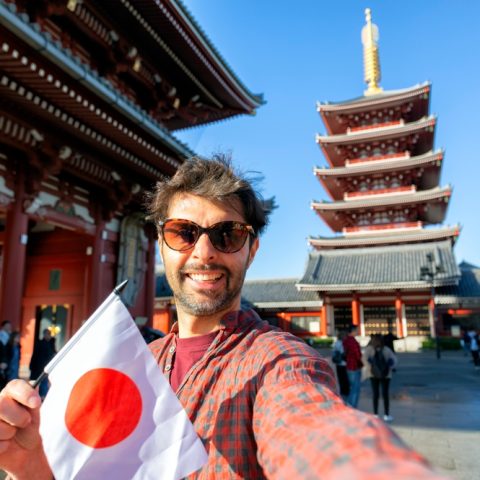
Located in the northeast part of the Tohoku region of Honshu we find Iwate, Japan’s second largest prefecture. Famous for boosting beautiful nature, both the gorgeous mountain landscape and scenic seaside, Iwate invites many visitors to enjoy the prefecture’s natural resources. Although the beauty of the area might draw you in, we are sure that the food will be what you leave remembering. Most famous is probably The Three Great Noodle Dishes of Morioka, 盛岡三大麺. In this article, we’ll take you on a food journey through Iwate, presenting the top 5 things you need to try when visiting this region!

Wanko Soba
Wanko Soba is a popular local favorite way to eat soba noodles. The word wanko means wan; bowl, and ko; small, indicating the way in which this dish is served. Instead of getting one large bowl of noodles, the typical way of serving soba, you receive a small bowl with a bite-sized portion of soba inside. Once you’ve eaten the soba in your small bowl, you will immediately get served with your next one, and this continues until you place a lid on your final bowl, signaling that you’d wish to stop eating. If you’d like to read more on wanko soba, check out our blog post about this intriguing dish here. Since Iwate prefecture is famous for their noodles, the soba is delicious in itself, but you’ll also receive various condiments to mix with your noodles, such as a sauce for dipping, wasabi, green onions and grated daikon radish. Not only delicious but also a truly fun way to explore noodles culture in Iwate!

Photo by Food in Japan
Reimen
Reimen are cold noodles typically eaten during summer. The dish has its roots in Korea and is often served as a side dish at yakiniku barbeque restaurants in Iwate, especially in Morioka city. The noodles are made from a dough of starch and potatoes, resulting in a silky and slightly chewy texture. The soup which the noodles are served in is made by beef and chicken stock, creating a hearty flavor to contrast the light noodles. The dish is often topped with spicy and crunchy kimchi, giving it a nice kick despite being served cold. Typically, locals finish off their extended yakiniku meal with a bowl of reimen, which is then followed up by a plate of fresh fruit, putting a refreshing end to a long and hefty meal.

Photo by Pyonpyonsha
Morioka Jajamen
The third great noodle dish of Morioka is Morioka jajamen, a dish consisting of flat noodles topped with a miso-meat sauce and julienned cucumber. It is said to have originated at a Chinese restaurant in Morioka, perhaps being a Japanese version of the popular Chinese dish zhajiangmian, which also inspired the similar Korean favorite jajangmyeon. Morioka jajamen is made up of a delicious balance of different flavors; the salty and savory miso-meat sauce, the fragrant garlic and refreshing cucumber come together in a well-balanced and addicting dish. Unlike wanko soba and reimen, Morioka jajamen does not have a soup for the noodles to soak in, so locals like to enjoy this dish by eating all the noodles, then cracking a raw egg into the bowl and pouring over some boiling water. Mixing the egg and water with the leftover miso-meat sauce creates a soup Iwate natives call chitantan, a tasty way to experience the flavors of the dish in an alternative way.

Photo by Maesawa Gyu Ogata
Maesawa Beef
Maesawa Beef is a type of wagyu, Japanese beef, from Iwate. It is a local delicacy and farmers have to make sure that their beef lives up to the high standards set for their cattle to be able to claim to be proper Maesawa beef. The meat is beautifully marbleized, with white specks carefully spreading over the red meat. The fatty marbleization in Japanese beef is to ensure that the meat is not tough and has a ‘melt-in-your-mouth’ feel to it. To make sure that Maesawa cattle are fatty and tender, they have to grow up in a stress-free environment with high quality food. Some popular ways to enjoy Maesawa beef is by eating it yakiniku style, enjoying it in a sweet and savory sukiyaki, or by eating it rare or even raw, in the form of nikusushi, meat sushi.

Photo by Eats
Kitakami Croquettes
Did you know croquettes are immensely popular in Japan? Mostly made with white potatoes, croquettes have been a staple street food in Japan. In the Kitakami area of Iwate prefecture, they are made using local Kitakami taro yams, resulting in a unique texture. It is also often filled with Maesawa beef, Kitakami shirayuri pork or asparagus, Iwate’s biggest export. This mixture results in a croquette that is crunchy on the outside yet soft and warm as you bite into it.
If you are a true noodle lover, Iwate prefecture might just be the perfect destination for you. This area is not only rich in delicious local produce, its people also know how to prepare it in the most delicious way possible. Enjoy yummy food, abundant nature and a rich history in this beautiful region!
Featured image by Shino on Unsplash
Join us on a delicious food experience during your trip in Japan!




